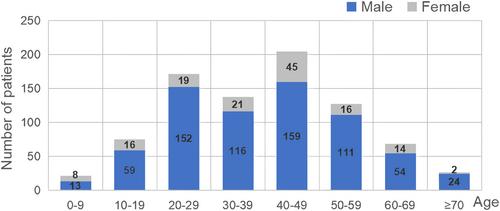Factors influencing traumatic brain injuries in maxillofacial fractures: A 12-year retrospective analysis of 2841 patients
Abstract
Background/Aim
Results of studies investigating the association between traumatic brain injury (TBI) and maxillofacial fractures (MFs) have varied considerably. The present study aimed to evaluate the correlation between TBIs and MFs, as well as the impact of age, sex, trauma mechanism, and season on TBIs.
Materials and Methods
This 12-year retrospective study of 2841 patients used univariate and multivariate logistic regression to assess the association between MFs and other factors impacting TBIs.
Results
Among 2841 patients, 1978 TBIs occurred in 829 (29.2%), with intracranial injuries (n = 828) is the most common. Of 829 patients with TBIs, 688 were male and 141 were female, corresponding to a male-to-female ratio of 4.9:1.0. The most common age group was 40–49 years (24.6%). Vehicles (including motor vehicles and electric vehicles) accidents were the primary causes of injuries. Multivariate regression analyses revealed an increased risk for TBIs among males (odds ratio [OR] 0.632, p < 0.001). Patients >40 years of age were at higher risk for TBIs, especially those ≥70 years (OR 3.966, p = 0.001). Vehicle accidents were a high-risk factor for TBIs (OR 6.894, p < 0.001), and winter was the most prevalent season for such injuries (OR 1.559, p = 0.002). Risk for TBI increased by 136.4% in combined midfacial and mandibular fractures (p = 0.016) and by 101.6% in multiple midfacial fractures (p = 0.045). TBIs were less common in single mandibular fractures, notably in single-angle fractures, with a risk of only 0.204-fold.
Conclusion
TBIs in MFs were significantly correlated with sex, age, aetiology, season and fracture location. Maxillofacial surgeons and emergency physicians must be aware of the possible association between TBIs and MFs to assess and manage this complicated relationship in a timely manner.


 求助内容:
求助内容: 应助结果提醒方式:
应助结果提醒方式:


